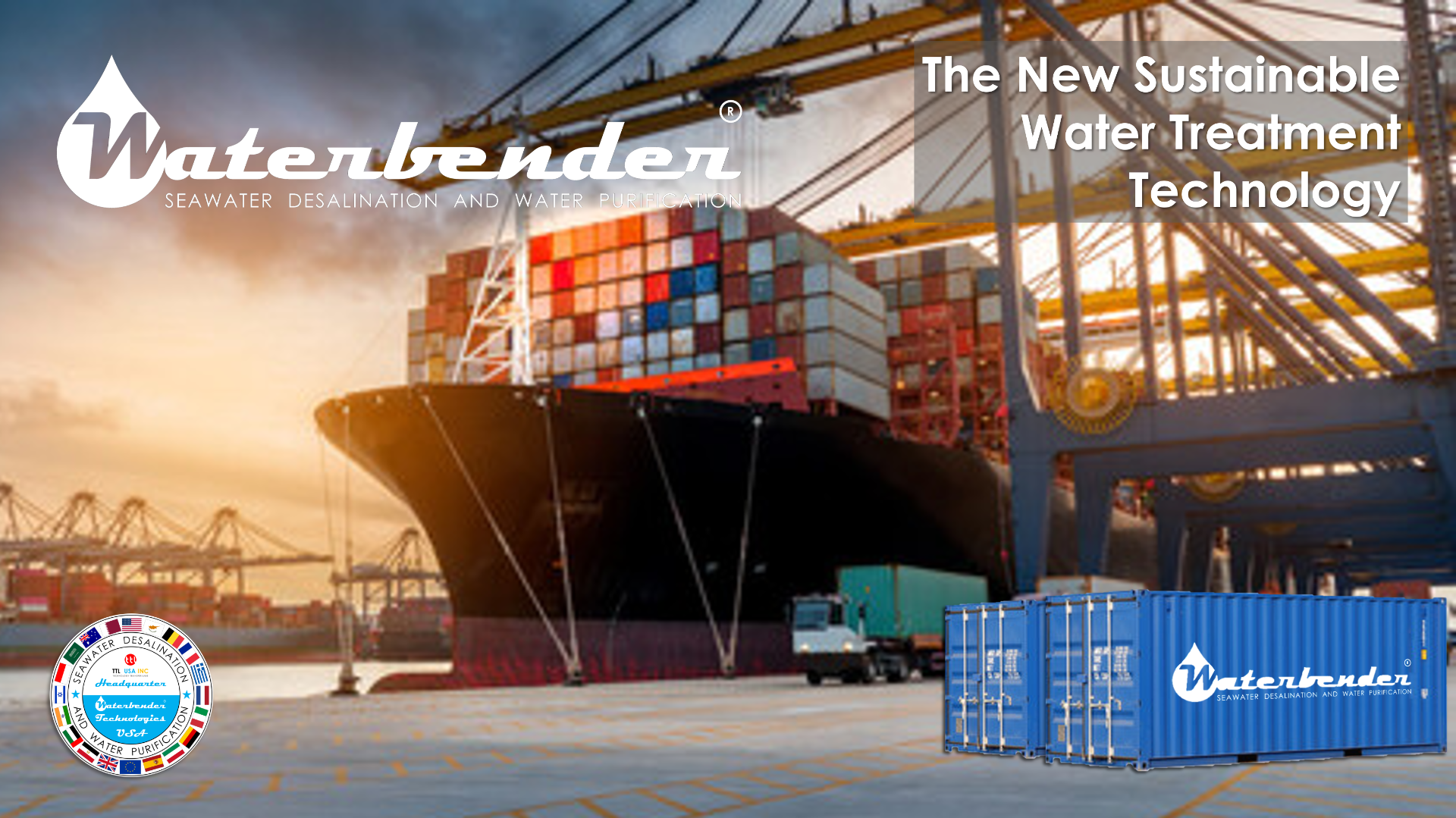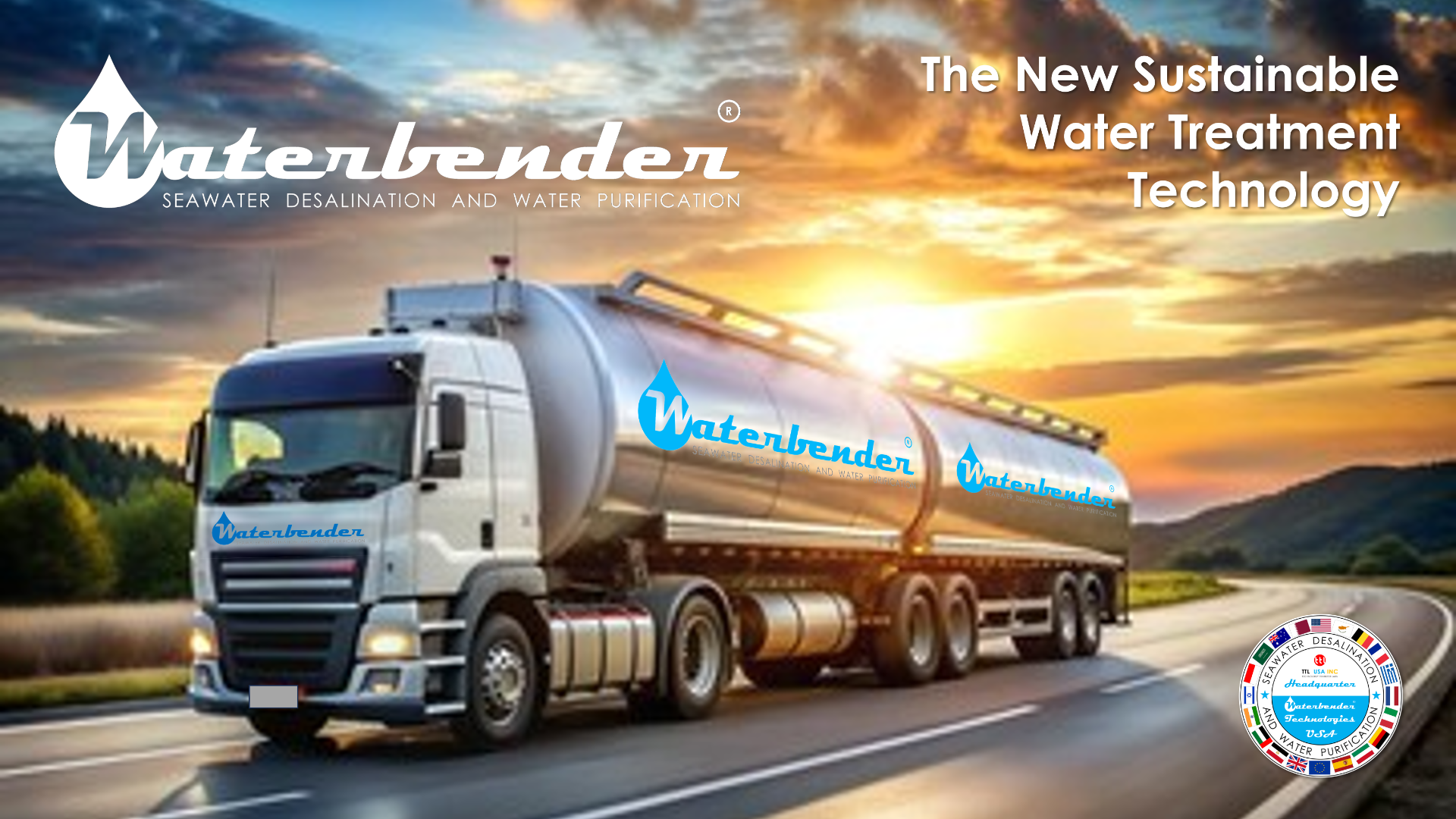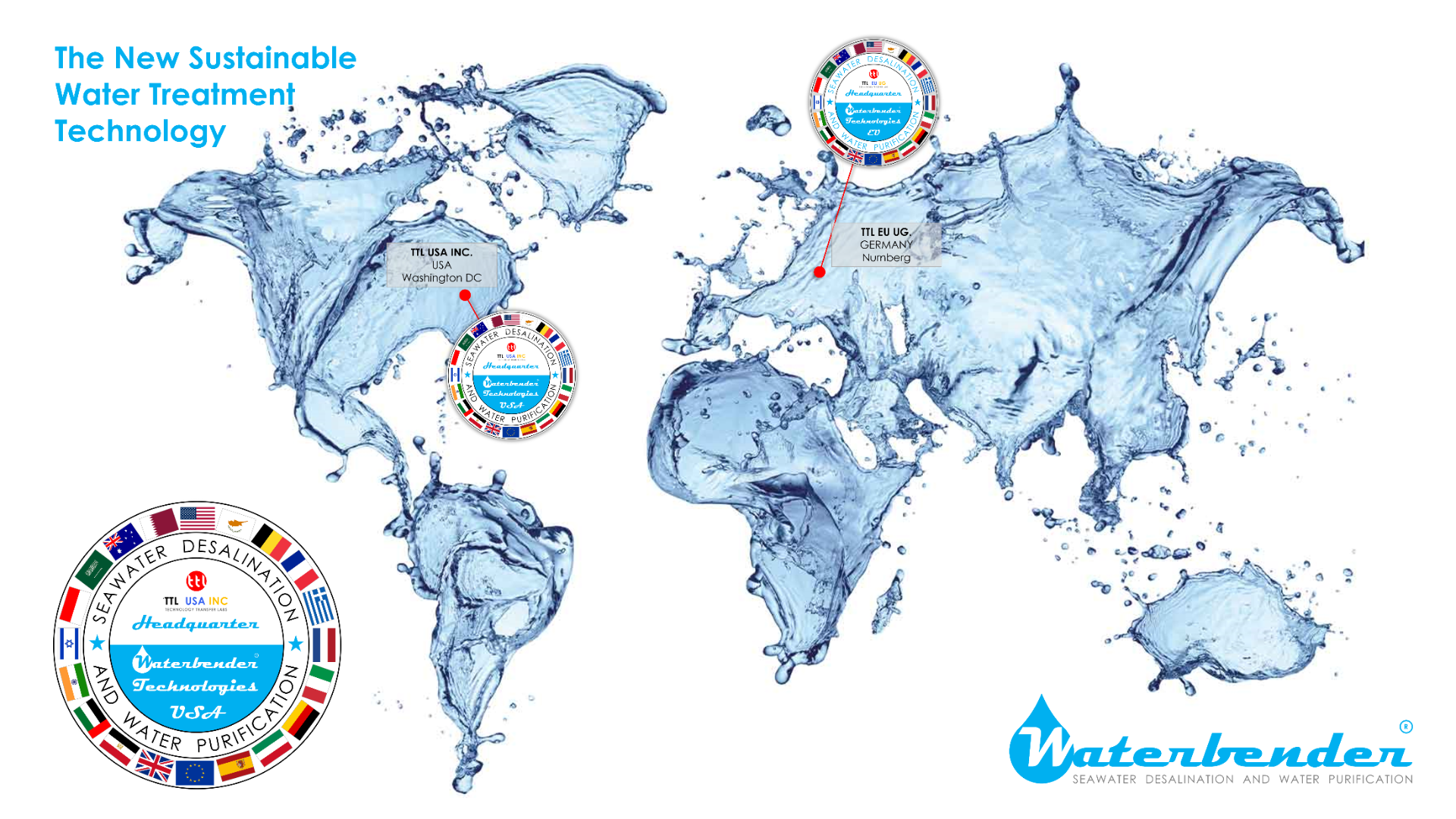Seawater Desalination and Water Purification

Introducing the Waterbender Technologies
Waterbender Technologies are universal, covering more than 18 different application areas, including desalination of seawater; complete purification of brines; treatment of chemical wastewater, pyrolysis liquids, and ballast water; as well as the removal of arsenic, lead, mercury, and other groundwater contaminants.
The system is extremely low in energy consumption and is capable of harnessing wind energy as well. It does not require consumables, filters, membranes, chemicals, reagents, inhibitors, coagulants, filters, cathodes, anodes, etc. Productivity can be increased by using multiple 40-foot-long, linearly expanding capacity devices.
Of the 18 scenarios of Waterbender Technology, three particularly significant areas are included here.
Seawater Desalination
Waterbender - Seawater Desalination Technology offers significant advantages over traditional reverse osmosis (RO) methods in water treatment. While standard RO technology typically generates 40-50% wastewater (brine) with an increased salt concentration of 8%, posing a threat to marine ecosystems, Waterbender - Seawater Desalination Technology eliminates this issue by producing 100 tons of potable water and only 4 tons of wet salt from the same volume of seawater, without introducing pollutants back into the ocean. In contrast, standard RO yields around 40-60 tons of purified (non-potable) water per 100 m³ of seawater.
The application of Waterbender - Seawater Desalination Technology in existing reverse osmosis facilities enables
- Doubled volume of potable water production
- Complete halt of harmful brine waste release into the ocean
- Adaptation of this distinctive and unique technology for specific purposes
Waterbender Treatment of Oil & Ballast Water
Waterbender - Oil & Ballast Technology applies innovative thermodynamic processes for the efficient purification of various types of water contaminants, with a focus on oil and oil products, including ballast water contaminated with chemical reagents and sediment from tanker vessels. Waterbender - Oil & Ballast Technology includes the following applications:
- Ballast water treatment
- Highly purified fresh water suitable for storage, industrial use, or environmentally safe release into natural water sources
- Separated oil and oil products with low emulsion
- Solid sediment consisting of chemical substances mixed with seawater
- Hydraulic fracturing water treatment
- Fresh water in large quantities
- Propping agents (small particles, such as sand or ceramics) that maintain fractures in the rock formation during the fracturing process
- Chemical additives, including surfactants, biocides, pH regulators, and other substances, along with trace fracture inhibitors.
Waterbender Treatment of Radioactively Contaminated Water
Waterbender - Radioactive Water Purification Technology is capable of completely removing radioactivity from water. This radioactive pollution can occur from artificial sources, such as the cooling of nuclear reactor fuel elements, as well as from natural sources when groundwater flows underground through granite and other radioactive materials.


The Problem is
The Solution

Why Waterbender Technology?
Pioneering sustainable solutions in water desalination,
brine conversion, and water waste treatment.

Desalination Efficiency
- Achieve 100% Water Desalination Excellence
- Remarkably Low Net Energy Consumption (Under 1 kWh/m3)
- Zero Liquid and Brine Discharge
- Doubled Revenue from Water Compared to RO System
- Production of Wet Technical Salt
- Integrating with RO system (Waterbender - Brine Utilization Technology)
- Double the Water Production
- Integration with Existing RO Plants

Cost Efficiency
- Modular Design for Easy Setup and Scalability
- Minimal Moving Parts for Streamlined Operation and Maintenance
- Low-pressure Operation, Eliminating High-Pressure Pumps
- No Chemicals or Membranes, Reducing Operational Complexities
- Lower Investment Compared to RO
- Small Footprint Maximizing Space Utilization
- Lower Equipment Costs Ensuring Financial Viability

Sustainability and More
- Zero-Liquid Discharge for Environmental Responsibility
- Minimal CO2 Emissions for a Green Approach
- Versatile Application Across Various Industries
- Deployment Anywhere, Enabling Desalination on Vessels
- Adaptable and Versatile Design Suited for Various Industries & Applications
- Enhanced Profitability, Cost-Effectiveness, and Efficient Operation
- Remote Management Reducing Labor Needs
500 m³/day Drinking Water Production with the Waterbender Seawater Desalination & Water Purification System
Waterbender Seawater Desalination & Water Purification System is a groundbreaking technology that employs innovative thermodynamic processes, and a low-temperature desalination method to purify any water source from natural and artificial introduced pollutants.
Waterbender is very efficient, low maintenance, and low in operational cost. It operates without the need of chemicals, reagents, inhibitors, coagulants, filters, cathodes, anodes, and it produces pure high-quality water. Our plants are scalable and can be custom designed to fit any capacity and needs. With a pioneering thermodynamic low-temperature technology at its core, this groundbreaking solution redefines the standards of efficiency, sustainability, cost-effectiveness and minimizing ecological footprint.
Waterbender Benefits
- Versatile application across various industries
- Modular design for easy setup and scalability
- Small footprint maximizing space utilization
- Fast deployment anywhere around the world
- Remarkably low net energy consumption (under 1 kWh/m3)
- Low maintenance and low maintenance cost
- Remote management reduces labor needs
- Lower equipment costs ensure financial viability
- No chemicals or membranes, reducing operational complexities
- No wastewater
- Low CAPEX and OPEX and fast ROI
Seawater Reverse Osmosis (SWRO)
Unlike our Waterbender, Seawater Reverse Osmosis is a very inefficient and expensive to operate process. It produces more wastewater than drinking water, 30-50% of drinking water and 50-70% of wastewater (brine). The produced brine water is hazardous and requires a safe disposal to avoid a negative impact on the surrounding environment and its biodiversity, as a result, there is an increased and ongoing cost of operations. In addition, RO removes 92-99% of healthy minerals such as calcium and magnesium which can lead to imbalances and serious health problems, and has a lower pH, making the water more acidic and increasing the risk for gastrointestinal issues to list a few. RO also requires the use of filters and membranes that need to be replaced regularly, it consumes a lot of energy 3-7 kWh/m³, requires pretreatment and post-treatment, and it is a complex system with many moving parts increasing the risk of breakage, malfunctioning and ongoing replacement to list a few.
Seawater Reverse Osmosis Disadvantages
- Wastes significantly more Water than it produces
- High energy consumption (3-7 kWh/m³)
- Requires pretreatment and post-treatment
- High cost of filters and membranes' replacement
- Diminishing capacity and quality do to clogging and damage of the system
- Use of chemicals
- Micro-plastics contaminations
- Mineral loss and acidic pH
- Corrosion and toxic metal contamination
- Uses costly high-pressure pumps that require regular replacement
- High CAPEX and OPEX and slow ROI


Simple Modular Design
Waterbender is a simple modular designed technology line with a capacity of 75 m³/day. It allows fast deployment, fast setup, and provides the flexibility and scalability to meet any water capacity needs. Waterbender system is extremely low in energy consumption (under 1 kWh/m3) and can operate off grid utilizing solar panels. Each technology line consists of only two WB tank units, evaporating and condensation tank with a wet salt unloading unit and controller. Each technology line is 2.5 m x 17 m and an additional 1.5 m manipulating area around the unit. Totaling a small footprint of 99 m² per technology line.

Waterbender Seawater Desalination 500 m³/day production
7 x 75 m³/day technology line required to produce 504 m³/day Drinking Water
Total land requirement for technology lines: 29.5 x 20 m (96.78 x 65.61 ft) = 590 m² (6,350.71 sq ft)
Total land requirement including roads 58 x 30 m (190.3 x 98.4 ft) = 1,740 m² (18,730 sq ft)
Additional functional units and areas required include an office building with a control room, an entrance gate featuring a 24-hour reception, barrier and ID access control, a camera system, a service building, internal roads and parking spaces, as well as a fenced operational area.

The number of professionals working in operations at the project site
The operation runs continuously, 24 hours a day, organized into three shifts, each requiring 1 shift supervisor and 1 technical operator. Therefore, across three shifts, a total of 3 shift supervisors and 3 technical operators are required. In total, the recommended staffing for the WB Project site, which includes office personnel, amounts to 8 individuals.
- 1 technology director (engineer, quality inspector) - 8 hours of office work,
- 3 shift supervisors (technicians) - 24/7 in three shifts,
- 3 technical operators (ski led workers) - 24/7 in three shifts,
- 1 administrator - 8 hours of office work.
Total: 8 individuals (operating 24/7 in three shifts, with office hours of 8 hours).
Operational process of WB Technology
- Phase Change - Optimized thermodynamical condition within the evaporation chamber to maximize the evaporation intensity throughout the process
- Separation - Water and salt molecules are separated during inter-band transition cycle
- Concentration - The vapor is transferred to concentration chamber. Resultant steam concentrates and condensates into clean potable water. Energy is recuperated.
- Salt Extraction- Salt accumulates inside the evaporation chamber. Salt is removed without interruptions to the desalination process.
- Output- Consumption-ready, lightly mineralized, superior-quality soft water.
Price of 500 m³/day – Ask for our price offer!
The price includes the Feasibility Study according to the local adaptation needs of 500 m³/day WB Technology, technological manufacturing design, full-scale production, on-site delivery, technological installation, trial operation, and training.
Completion Time frame: 12 months
Payment schedule. The project implementation has 5 milestones.
The price does not include
- The costs of the necessary permitting procedures (building permits, technology permits) at the implementation site
- The cost of constructing the necessary road network and car parks on the site. The cost of the concrete foundations for the plant units (Waterbender),
- The acquisition of a fleet of trucks suitable for the transport of wet salt and the operation of the transport.
- The legal and notarization fees on-site, as well as the cost of the land required for the construction of the plant and the costs of property development (office building, reception, site development).
Waterbender additional profit option 2024 market prices for wet salt $60-$130/ton
The global industrial salt market was valued at USD 13.67 billion in 2022 and is projected to reach USD 17.43 billion by 2028, reflecting a compound annual growth rate (CAGR) of 4.13% during the forecast period. The predominant application of salt lies within the chemical industry, especially in the production of chloralkaline products and synthetic soda ash.
By 2028, shipments in the global industrial salts market are anticipated to hit 389.51 million tons. Industrial salt is utilized for various non-food applications, including chemical manufacturing, water treatment, and de-icing. It boasts more than 14,000 uses, spanning dye setting, glassmaking, and tire production. Approximately 60% of global salt production is dedicated to industrial applications.
Bulk Salt Consumers
- Road Maintenance and De-icing
- Water Treatment Facilities
- Food Processing and Preservation
- Agriculture
- Chemical Industry
- Pharmaceuticals
- Leather Tanning and Dyeing
- Oil and Gas Industry
- Mining
- Pulp and Paper Industry
- Textile Industry
- Pool Maintenance
- Dehumidifying Solutions
Seawater Reverse Osmosis (SWRO) high wastewater (brine) generation and power consumption
Standard ROtechnology typically generates 40-70% wastewater (brine) with an increased saltconcentration of 8% and additional chemical and microplastic contaminants that pose a threat to our ecosystems. Additional brine water treatment is required. Our Waterbender system on the other hand, offers significant advantagesover the traditional seawater reverse osmosis (SWRO) methods in water treatment, making it a more efficient, profitable, cleaner and environmentally friendly solution.

Additional Wastewater treatment requirements for Seawater Reverse Osmosis (SWRO)
Surface water discharge CAPEX $130-600/m³ - OPEX $0.05 - $0.30/m³
This method is suitable for desalination plants of all sizes.
- Harm to marine ecosystems
- Decrease dissolved oxygen of seawater
- Need to be near surface water
Sewer discharge CAPEX $30-120/m³ - OPEX $0.32 - $0.66/m³
This method dilutes the brine with ambient seawater.
- Rarely used in seawater desalination plants
- Harm to marine ecosystems
- Decrease dissolved oxygen of seawater
- Need to be near the coast
- More expensive than surface water discharge
Deep-well injection CAPEX $300-500/m³ - OPEX $0.54 - $2.65/m³
This method is suitable for inland desalination plants and doesn't harm marine ecosystems
- Not suitable for areas with high seismic activity and permeable strata
- Causes groundwater pollution
- Causes soil pollution
- High operational and maintenance cost
Evaporation pond CAPEX $2,800 - 3,600/m³ - OPEX $3.28 - $10.04/m³
This method is suitable for inland desalination plants and doesn't harm marine ecosystems. It is also easy to operate.
- Needs large areas of land
- Causes groundwater pollution
- Causes soil pollution
- High operational cost
Versatile Waterbender Technologies can be deployed across various industries
The Waterbender Technology employs innovative thermodynamic processes, a low-temperature desalination method to purify any water source from natural and/or artificially introduced pollutants. Waterbender can purify any water source from chemicals, petroleum products, heavy metals, harmful minerals, particles and many more pollutant sources. Our technology can be effectively used in the following industries:
- Reverse osmosis plant, brine water purification
- Ballast water cleaning
- Hydraulic fracturing
- Petrochemical industry
- Offshore oil platforms
- Manufacturing industry
- Agriculture, horticulture and irrigation
- Mining industry
- Cooling tower water treatment
- Boiler water treatment
- Waste recovery, wastewater treatment
- Marine industry
- Pulp & Paper Industry
- Data center water treatment
- Microelectronics
- Biofuels & Ethanol Industry
- Food & Beverage water treatment
- Textile Industry
- Hospitals and healthcare operations
- Radioactive water purification
- Deuterium technology, production of heavy water
- Power generation Industry
- Municipal wastewater treatment
- Lithium extraction
- Natron cleaning, crystallization
- Sapropel organic fertilizer production
- Water pollution cleanup
- Disaster response
And more
If you are interested in the technology or have any questions, please contact us!

